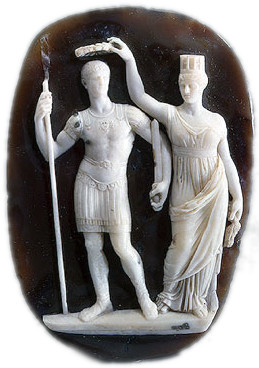Bitva u Adrianopole (324)
| Bitva u Adrianopole | |||
|---|---|---|---|
| konflikt: Občanské války tetrarchie | |||
 Bitva u Adrianopole | |||
| Trvání | 3. července 324 | ||
| Místo | poblíž Adrianopole | ||
| Souřadnice | 41°40′12″ s. š., 26°31′30″ v. d. | ||
| Výsledek | vítězství Konstantina I. | ||
| Strany | |||
| Velitelé | |||
| Síla | |||
| |||
| Ztráty | |||
| |||
| Některá data mohou pocházet z datové položky. | |||
Bitva u Adrianopole v roce 324 n. l. byla střetnutím vojsk západního císaře Konstantina Velikého s armádou východního císaře Licinia. Její příčinou byly dlouhodobé politické neshody mezi oběma spoluvládci Římské říše. Proběhla 3. července 324 poblíž města Adrianopol v Thrákii (dnes Turecko) a skončila vítězstvím Konstantinových jednotek. Licinius sice nebyl v občanské válce zatím poražen definitivně, jeho postavením však prohraná bitva značně otřásla.
Média použitá na této stránce
Autor: Ssolbergj, Licence: CC BY 3.0
Vexillum of the Roman Empire.
Autor: Tento vektorový obrázek byl vytvořen programem Inkscape ., Licence: CC BY-SA 3.0
Labarum of Constantine I (Vexilloid of the Roman Empire). Drawn after File:As-Constantine-XR RIC vII 019.jpg; the three dots represent three "medallions" or portraits that could not be rendered in detail on the coin, c.f. File:Konstantin den stores labarum, Nordisk familjebok.png
c.f A. Macgeorge, Flags, Glasgow, 1881:
- "The vexillum was a standard composed of a square piece of cloth fastened to a cross bar at the top of a spear, sometimes with a fringe all round, and sometimes fringed only below, or without a fringe, but draped at the sides, When placed over the general's tent it was a sign for marching, or for battle. The labarum of the emperors was similar in form, and frequently bore upon it a representation of the emperor, sometimes by himself and sometimes accompanied by the heads of members of his family. [...]"
Sardonyx cameo depicting constantine the great crowned by Constantinople, 4th century AD
18.5 x 12.2cm [1]

